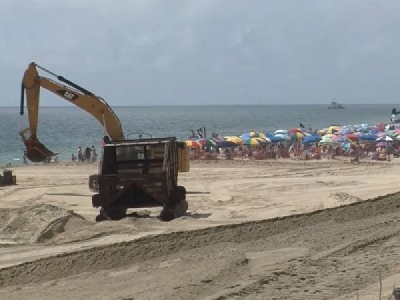
Posted on November 1, 2018
The U.S. Army Corps of engineers says roughly $66 million has been invested into dune and beach replenishment projects in Delaware since Hurricane Sandy.
The corps says of that $66 million, Lewes received $3 million, Rehoboth and Dewey received $24 million, Bethany/South Bethany received $27 million and Fenwick Island received $12 million. The act of dredging sand and widening beaches is often associated with protecting Delaware’s coastal towns and therefore its tourist economy. But the head of the state’s Shoreline and Waterway Management Program say beach replenishment is the mainline of defense against coastal storms.
“Delaware’s beaches for the most part are eroding and moving landward in a time of rising sea levels,” explains Program Manager Mike Powell. “We’ve built near the coast in many areas and with eroding beaches we are replacing the sand to kind of buffer against the impact of beach erosion on our built environment, things like roads, and boardwalks, infrastructure, buildings.”
Powell likens replenishment to setting back the clock. He says in addition to traditional dredging projects, the Department of Natural Resources and Environmental Control has trucked in sand to various northern bay beaches like Kitts Hummock and Bowers Beach.
One place DNREC has not replenished? Delaware’s state parks.
“The northern part of Delaware’s Atlantic ocean coast has a really strong south to north literal transport of sand,” says Powell. “A lot of sand is moving from south to north and eventually to the spit at Cape Henlopen so sand that is placed in Rehoboth and Dewey has a very pronounced tendency to move north.”
Powell says says another reason why state park beaches have not been traditionally replenished is that the parks are able to move parking lots and other features in order to accommodate natural processes, something that cannot exist in built up beach towns there in Sussex County.
Federal money for replenishment comes from Energy and Water Appropriations by Congress. State money comes from Delaware’s lodging tax. Of the eight percent tax on hotels and motels, one percent goes to beach nourishment projects. In recent beach replenishment projects, the federal government has paid 65 percent of the project costs, with Delaware paying the remaining 35. Recent replenishment cost roughly $17 million in Bethany, South Bethany and Fenwick Island, a number some found staggering.
“I refer to it as a sandcastle,” says surfer Bruce Mears. “Even kids know if they build a sandcastle it’ll wash away with the first high tide. Why do we need a $17 million sand castle?”
Mears says he has no problem with replenishment as a process, but claims replenishment can cause dangerous shorebreak if the wrong type of sand is used.
“Shorebreak is created by an extreme drop off. The smallest wave can pack a powerful punch,” he says. “I call it pump and dump. They bring the sand in from offshore, they dump it on the beach, they bulldoze it to the point of where they are supposed to stop and you get an extreme drop off.”
Mears says tapering the sand would also help the issue, as would providing more notification to swimmers and visitors.
“No one would expect a one foot wave or a two foot wave typical like of the summer time to pack the punch that it packs,” he says.
Beach replenishment projects are likely to expand, as Senator Tom Carper unveiled $75 million in federal funding for a new pilot program. But in addition to replenishment, DNREC says municipal codes and regulations can help mitigate the damage from coastal storms.
How this summer’s beach replenishment will hold up will be determined during this storm season, with some towns recently expressing gratitude for the process before and after Hurricane Florence.
Source: WBOC16





